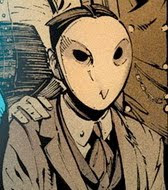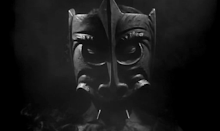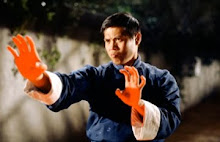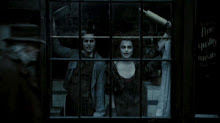

Violence, duty, and heritage passed down from one generation to the next. But muddled even in the passing. “ One day you’ll understand.” But Amsterdam’s understanding will only be partial. He will not understand in full because He is not his father.
Stepping outside the scene for a moment a crucial line that many miss in the film is when Amsterdam mentions that he has lost his regional accent in the orphanage. It could be taken as a line covering up DiCaprio’s, um dubious skills at accents (“Duhly Ahpointed Fehduhal Mahshaals) but it serves a larger purpose as well. Though he labels himself Irish, and is thus labeled by his enemies, to those in the home country he wouldn’t pass. Whether or not he likes it, Amsterdam is an American.

“Some of it I half remember. The rest I took from dreams.”
One of my favorite lines in film. Or any film. Though DiCaprio's voice over will occasionally become intrusive, the dreamy melancholy way that line is spoken is perfect.
Our first look at Neeson. Significantly we never see him in full until after he has dawned the costume of “Priest”. Like Amsterdam he exists in our minds as a larger then life figure, we have no memory of him as a man. Only as a Legend.



“Now Son who is that?”
“Saint Michael”
“WHO IS IT?”
“SAINT MICHAEL!”
“And what did he do?”
“He Cast Satan Out Of Paradise”
“Good Boy”
My distinguished colleague Peter Lenihan in his excellent (and now sadly absent from the blogosphere) essay on the film, stated that it is in Gangs that Scorsese admitted that he was more interested in Catholic Iconography then Catholic Theology. With all due respect to Peter this always seemed to me to be off the mark. And more then a little bit. There is hardly a film in Scorsese’s Ouevre (Last Temptation Of Christ being the rather obvious exception) that is powered more by Religion in general and Catholic Ideology in particular. It is at the heart of virtually every character. The thing that drives them, that frames their struggle in the mythic light they need in order to continue it.
Of course the irony of the film is that both Priest and Bill consider themselves the inheritor of the story. Both see themselves as Saint Michael and the other as Satan. Just as everyone who has ever fought to define what America means cannot help but see themselves completely in the right. Though given Bill resides in a place called Satan’s Circus, it’s not too tough to see where the film’s loyalties lie.
 I love Neeson's face in the above picture.
I love Neeson's face in the above picture. Note the mural of the Madonna and Child in the Celtic style on the back wall. The film blends the iconography of paganism and Christianity over and over again. To startling effect.
In speaking of the blend note too our first look at The Dead Rabbits. As with the Saint Michael Parable the link between Social Identity and thus social action and Religion is made explicit.




Gangs has a reputation for ultra violence that is at best half earned. It’s bloody no doubt. But rarely shows you as much as you think it does (More on this later). It’s just that the potential for violence is so clearly etched in the bedrock of every scene that at times it feels down right oppressive.
You can't have shots of weapons like that, and men like those and not remember that there is an excellent chance that the latter may begin to use the former.

Once again the wicker cross, the blending of Ireland’s two religious traditions. The wild haired Priest with the blood of Christ. It’s a darker wilder religion that is practiced by the characters of Gangs Of New York.



I treasure cinema’s ability to bring me to different worlds. And no film I know does that better then Gangs Of New York. Gangs Of New York has such a vividness to its sense place that it’s damn near hallucinogenic. That first journey through The Warren a staggering montage of sound and image never fails to leave me literally breathless.
Hardly have I ever seen a place so alive.





 The Rabbits even look smaller. No longer shot from low angles, their heads brushing the ceilings. This is not their terroritory.
The Rabbits even look smaller. No longer shot from low angles, their heads brushing the ceilings. This is not their terroritory. 
 "You can do this all with computers now." George Lucas told Scorsese when he visited the sets of Gangs Of New York. Continuing his contest to be the most hateful filmmaker in the world...
"You can do this all with computers now." George Lucas told Scorsese when he visited the sets of Gangs Of New York. Continuing his contest to be the most hateful filmmaker in the world... 


























































































































































































8 comments:
The main thing that sticks with me from Gangs is Lewis' performance. And his greasiness. I've only seen the movie once but I think it's the scene when he's all sweaty and greasy, wrapped in the flag, giving his speech about fear. That scene just makes me want to shower over and over again!
Shower in his awesomeness.
Has one of the best profane lines in that scene too "What is your mouth all glued up with cunny juice I asked you a question."
Bryce, once again you make my Saturday.
Your comment about the violence in the gang fight scene happening off camera is absolutely right, and I never realized it before. It reminds me of an episode of Siskel and Ebert I saw one time, shortly after Pulp Fiction was out, that they devoted entirely to Tarantino's then-short catalog. Ebert knocked down criticisms of Pulp Fiction and Reservoir Dogs, particularly that they were too violent, by pointing out that most of it happens off or below screen. (Bruce Willis' stabbing of the fat rapist with the samurai sword happens below the screen, Marvin's head getting blown off is signified jut by an exterior shot of the blood on the rear window, you don't actually see Mr. Blonde cutting off the cop's ear.)
I don't think I ever noticed the shining razor/shining cross you pointed out -- I'll have to rewatch to see that. But the fact that Priest uses his cross as a sheath for his sword also underlines that violence/religion theme.
One thing I love about this movie is how it reminds us that below the surface, this country has always been a mess -- "a handful of bitches and a few crusty rag tags" -- a collection of gangs with their own motivations, fears and desires, that are often opposed to others. E Pluribus Unum isn't a statement of fact, it's a prayer -- a wish for a dream that will one day come true.
And on that note, it thoroughly shows that the Civil War wasn't the clear white hat/black hat conflict between a united North to free the slaves from the South that other films depict.
Let's compare northern attitudes to the war in Gangs to those in Glory, for example. Aside from a few low-ranking Union army racists, Glory shows most white Northerners as racially enlightened and completely supportive of Lincoln and his emancipation ideals. (Granted, the film does primarily deal with officers and upper-class citizens when it shows white characters, which goes a long way to explain that.)
But Gangs, with its street-level view of the Civil War, shows a much less enthusiastic opinion of Lincoln, to say the least. The war and effort to abolish slavery are met with either disinterest (Amsterdam) or outright hostility and virulent racism (Bill). As great a leader as Lincoln was, and how correct he was to say that the time for slavery to end was long overdue, he did not have the rest of the North unified behind him.
So whaddaya know, I ended up spending Saturday morning rewatching GONY, and another piece of Bill's dialogue grabbed my ear as a favorite. It's the beginning of the scene in the whorehouse, where they go to celebrate after the failed assassination attempt at Uncle Tom's Cabin.
Bill's watching a black man dancing to a fiddle-and-banjo tune, and says "Look at that -- what in Christ's name is that? Rhythms of the Dark Continent, thrown into the kettle with an Irish shindig. Stir it around a few times, pull it out as a fine American mess. A Jig doing a jig."
Bill the Butcher's just prophesized jazz, country, rock and roll and pretty much every other bastard form of music America would ever produce.
Bryce, I wondered if Scenes had peaked with 'The Red Shoes'.
Damned if you haven't just raised the bar a tad higher!
Steve: As always thanks for the fine post. Excellent points all. I originally had a caption when Priest drew his weapon saying "There's nothing not awesome about a sword hidden in a cross."
Before stopping to reflect that, no in history there has been plenty not awesome about a sword in a cross.
Neil: Many thanks sir. Don't think the same idea in regards to The Red Shoes didn't occur to me.
Still these are a lot of fun to do (Despite being REALLY time consuming) so I'll do my best to keep raising the bar.
Daniel Day Lewis is one of my older man crushes!!!
Mine too.
Post a Comment